Physical Address
304 North Cardinal St.
Dorchester Center, MA 02124
Many perinatal cerebral injuries, brain malformations, and genetic mutations create distinctive and life-long neurologic, neuropsychologic, and physical impairments. Although usually apparent in infancy, some of these disorders do not become evident until childhood or adolescence. One explanation for the delay is that the time course of cerebral myelination, which begins in the third trimester of gestation and spreads from the brainstem to the cortex, is incomplete until the second year of life. Another explanation is that infants and young children, despite mild brain injury, may reach their early milestones, but eventually, they cannot meet the progressively more significant challenges, first of learning to walk, then speaking and drawing, and ultimately caring for themselves. Regardless of the age when neurologists detect children’s congenital impairments, they know that these children will grow up to be adults with the same impairments.
From the viewpoint of the Diagnostic and Statistical Manual of Mental Disorder, 5th Edition (DSM-5) , many of these disorders serve as a specifier —an underlying medical or genetic condition—for Neurodevelopmental Disorders and, for some, Autism Spectrum Disorder (ASD) . For example, a psychiatrist would say that a child has ASD Associated with Rett syndrome or another specifier for ASD ( Box 13.1 ). In contrast, neurologists look at the nomenclature from the perspective of the primary disorder. They would say, for example, that a child has Rett syndrome with symptoms of social and language regression, epilepsy, and repetitive hand writhing movements.
a Regression, loss of language skills, and hand flapping, and other stereotypies.
Angelman
Fragile X
Klinefelter
Landau-Kleffner
Neurofibromatosis type 1
Macrocephaly-ASD (PTEN mutation)
Rett
Tuberous sclerosis
Cerebral palsy (CP) is a nonscientific but generally accepted term that describes the permanent, nonprogressive neurologic motor system impairments that result from injuries or genetic abnormalities of the immature brain during fetal development (in utero) , delivery, infancy, or early childhood. Neurologists use the term “static encephalopathy” rather than “CP,” but because “CP” remains ingrained in the medical and lay public’s vocabulary, this book will continue to use it.
Several nonmotor problems routinely accompany but fall outside of the operational definition of CP. They include, most importantly, epilepsy and intellectual disability . As a rule, the incidence of epilepsy roughly corresponds to the severity of physical impairments and intellectual disability ( Fig. 13.1 ). Other common problems that accompany CP include deficits in vision and hearing, strabismus, dysarthria, poor school performance, and impaired social skills. Adults with CP, who have no intellectual disability, often have comorbid depression or anxiety. The DSM-5 does not define CP but allows for several comorbidities, including Intellectual Disability, Language Disorder, and Developmental Coordination Disorder.
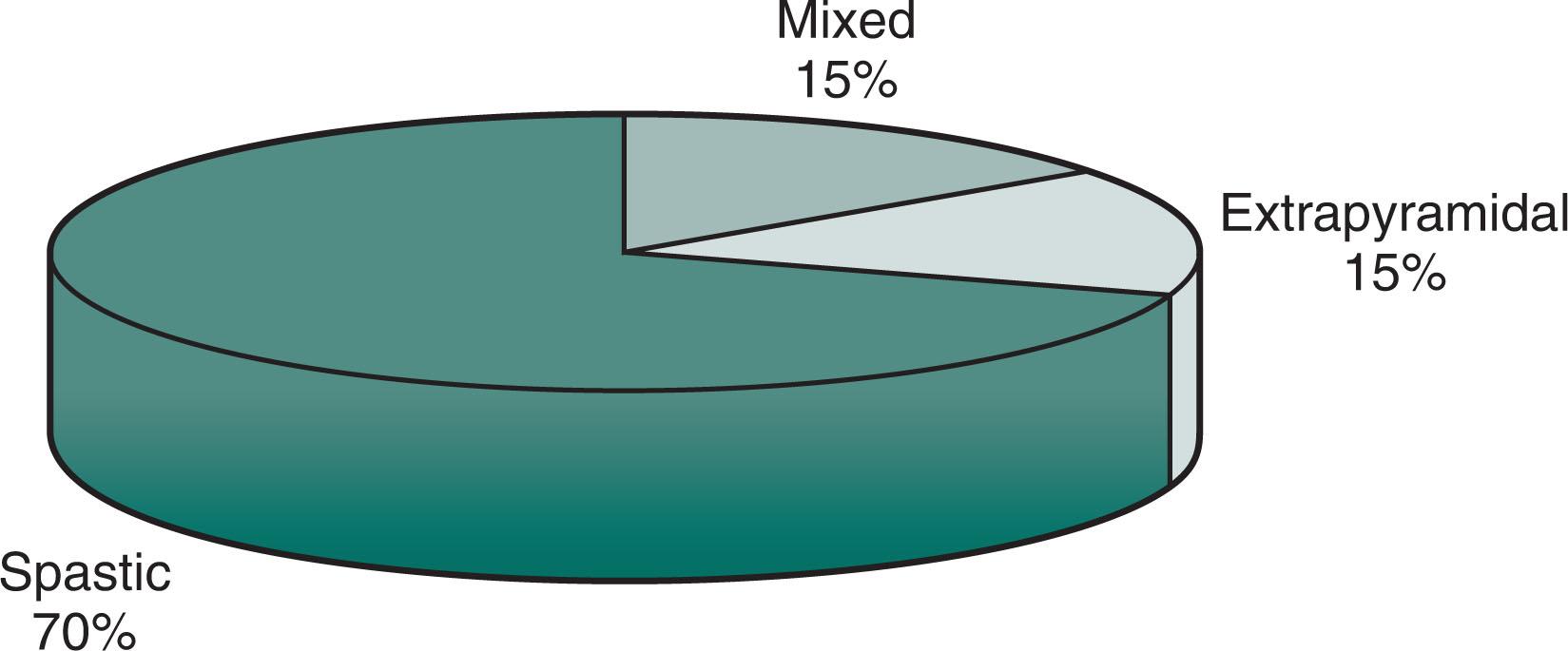
Neurologists attribute most cases of CP to prematurity and low birth weight, particularly weights less than 1.5 kg. Periventricular leukomalacia (damage to the white matter around the lateral ventricles) is the predominant pathology among premature infants. Other risk factors include hypoxia before or during labor, prolonged bradycardia, 10- or 15-minute Apgar score of less than 4, in utero intracerebral hemorrhage, perinatal ischemia, and postpartum multisystem organ failure. Modern prenatal, obstetric, and postpartum care have reduced the incidence of CP to about 2% of births. However, intensive neonatal care, a counterbalancing factor, has allowed preterm infants to survive with persistent motor and other neurologic impairments.
Whereas preventable obstetric injuries, such as anoxia, account for less than 10% of cases, unalterable antepartum factors account for more than 70%. For example, CP is often a manifestation of congenital malformations, such as microgyria (small cerebral gyri), pachygyria (thickened gyri), hydrocephalus, and porencephaly (see Fig. 20.4 ). Also, because 5% of children with CP have a first-degree relative with a similar condition, genetic factors undoubtedly determine or contribute to many cases. Many neurologists recommend genetic testing in children with CP.
Neurologists often divide CP into four varieties. Each has a characteristic motor impairment, such as spastic paresis or choreoathetosis ( Fig. 13.2 ), and incidence of its two significant comorbidities, epilepsy, and Intellectual Disability. Unlike motor impairments, these comorbidities may not appear before age 5.
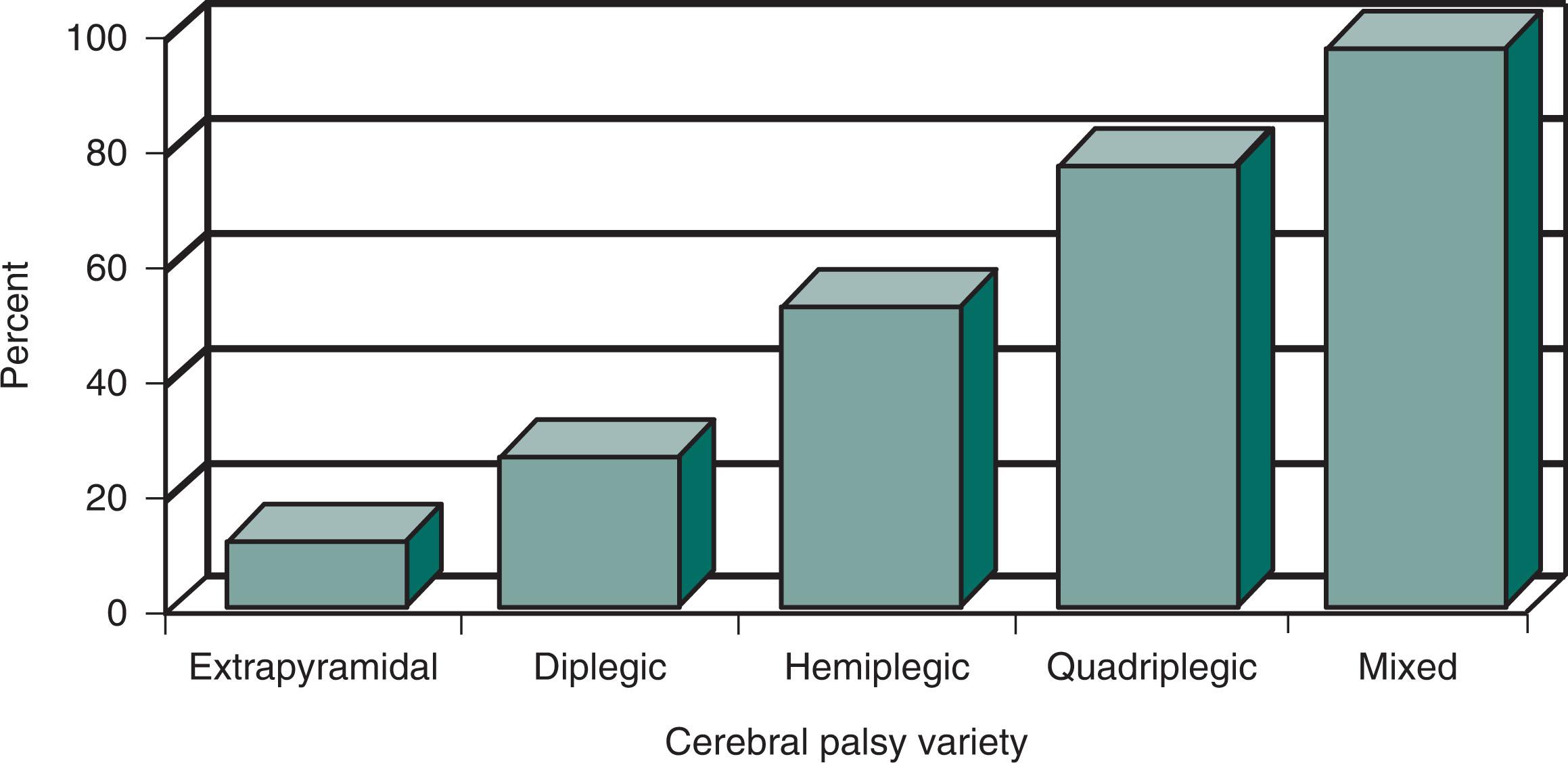
Neurologists usually do not diagnose CP until infants are at least 4 months old and, in some cases, not until they are 4 years old. Also, once children have an established motor deficit, it must not progress as they mature. Impairments may seem to recede as children learn compensatory strategies and benefit from various therapies.
Once assured that a child has a stable, congenital neurologic impairment rather than a childhood-onset neurodegenerative illness, such as a leukodystrophy (see Chapter 15 ) or Rett syndrome (see later), which will follow a downhill course, neurologists concentrate on the problem at hand by evaluating the child’s disabilities and abilities in intellect, learning, speech, and hearing as well as motor function. Because approximately 50% of children with CP have average intelligence despite significant motor deficits, neurologists have children with CP undergo individualized evaluations that, as much as possible, bypass motor impediments, dysarthria, hearing impairments, and other physical disabilities.
As a related issue, caregiver stress is a significant problem for parents and siblings of a child with CP. Moreover, unlike care for a child or adult with a neurodegenerative illness, care for a child with CP is endless.
In spastic CP, spasticity usually impairs mobility more than paresis. It causes slow, clumsy, and stiff movements that force affected children to walk with extended, unbending legs. The spasticity also precludes them from performing regular isolated movements, such as tapping one foot while keeping the other one immobile. Signs of upper motor neuron injury—hyperactive deep tendon reflexes (DTRs), clonus, and Babinski signs—usually accompany spasticity. They all can be clues to the diagnosis but are not required.
Due to the cerebral injury occurring prior to physical maturation, arms or legs, already weak and stiff, fail to grow to their proper length and have less than average muscle bulk. If the deficit is asymmetric, the thumb and great-toe nail beds are smaller on the abnormal side. A short Achilles tendon forces children to walk on their toes. Neurologists say the foreshortened limbs have growth arrest and asymmetry .
Diplegic CP (spastic diplegia) consists of bilateral symmetric paraparesis ( Fig. 13.3 ). It usually forces children to hold their legs straight, drawn together (adducted) and crossed over each other (scissored). Scissoring , an early sign of CP, forces children to keep their feet and toes pointed downward (extended). When babies with diplegic CP try to walk, this posture forces them to stand on their toes with their legs held closely together, i.e., adducted, which is an unstable stance.
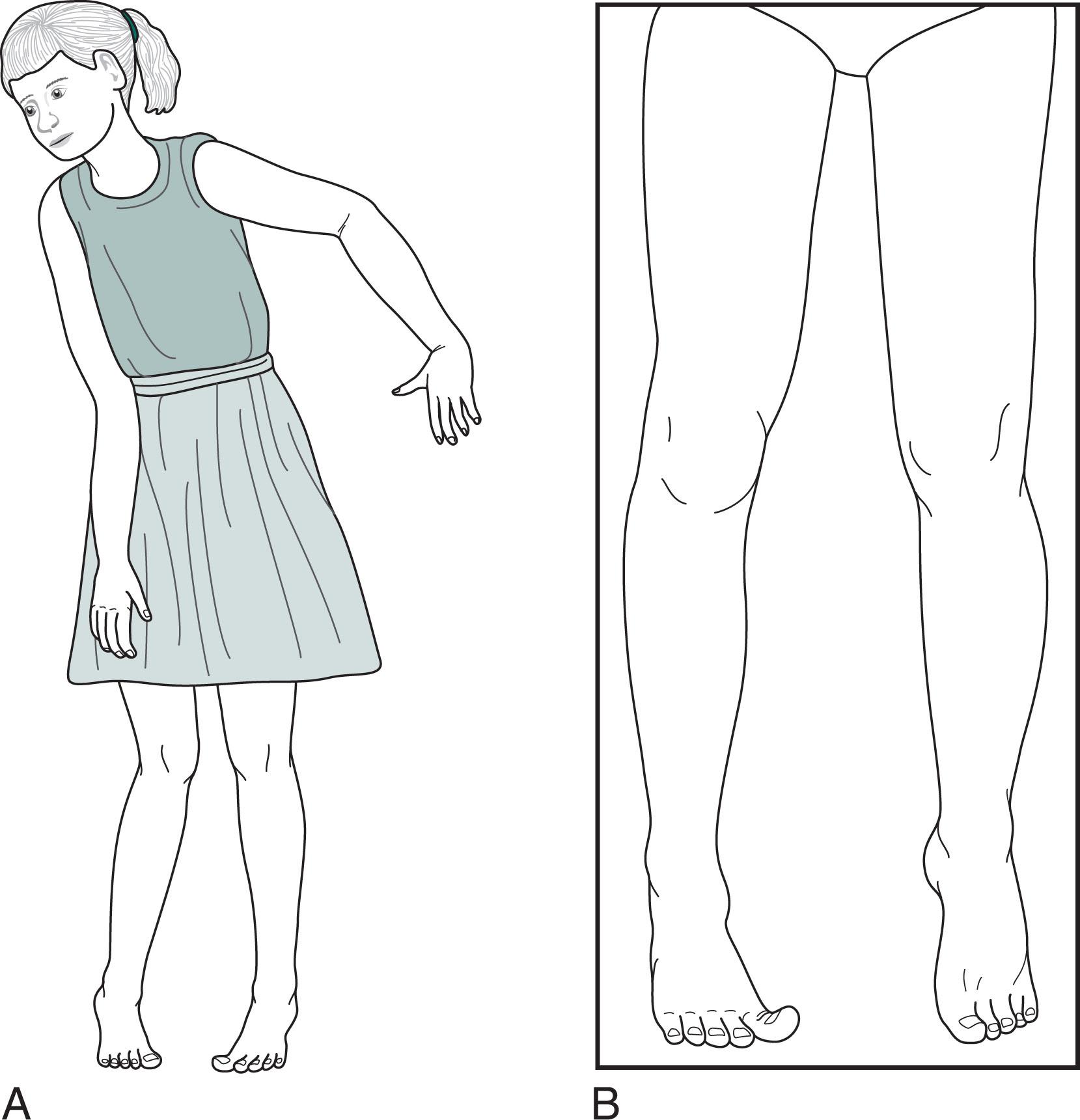
Neurologists usually find the diplegic CP variety in children who have been born prematurely and have sustained periventricular leukomalacia (softening or damage to the white matter around the lateral ventricles). Because the cerebral cortex has escaped significant damage, epilepsy and intellectual disability occur in a relatively small proportion (about 25%) of these children.
Hemiplegic CP consists of spastic hemiparesis affecting the face and arm more than the leg ( Fig. 13.4 ). Although the motor impairments of children and adults with hemiplegic CP resemble adults with strokes from middle cerebral artery occlusions, the impairments differ in three respects. While normal infants younger than 2 years old do not show hand preference, infants with hemiplegic CP show premature handedness. For example, unequivocal right-handedness in infants younger than 1 year old may mean that the left hand, if not the entire left arm, is paretic. Another difference is because left hemisphere injury during the perinatal period forces the right hemisphere to assume language control, children and adults with congenital right hemiparesis usually have no language impairment (aphasia), although a specific learning deficit may be evident when the child starts school. Finally, older children and adults with hemiplegic CP show growth arrest and asymmetry of the affected limbs.
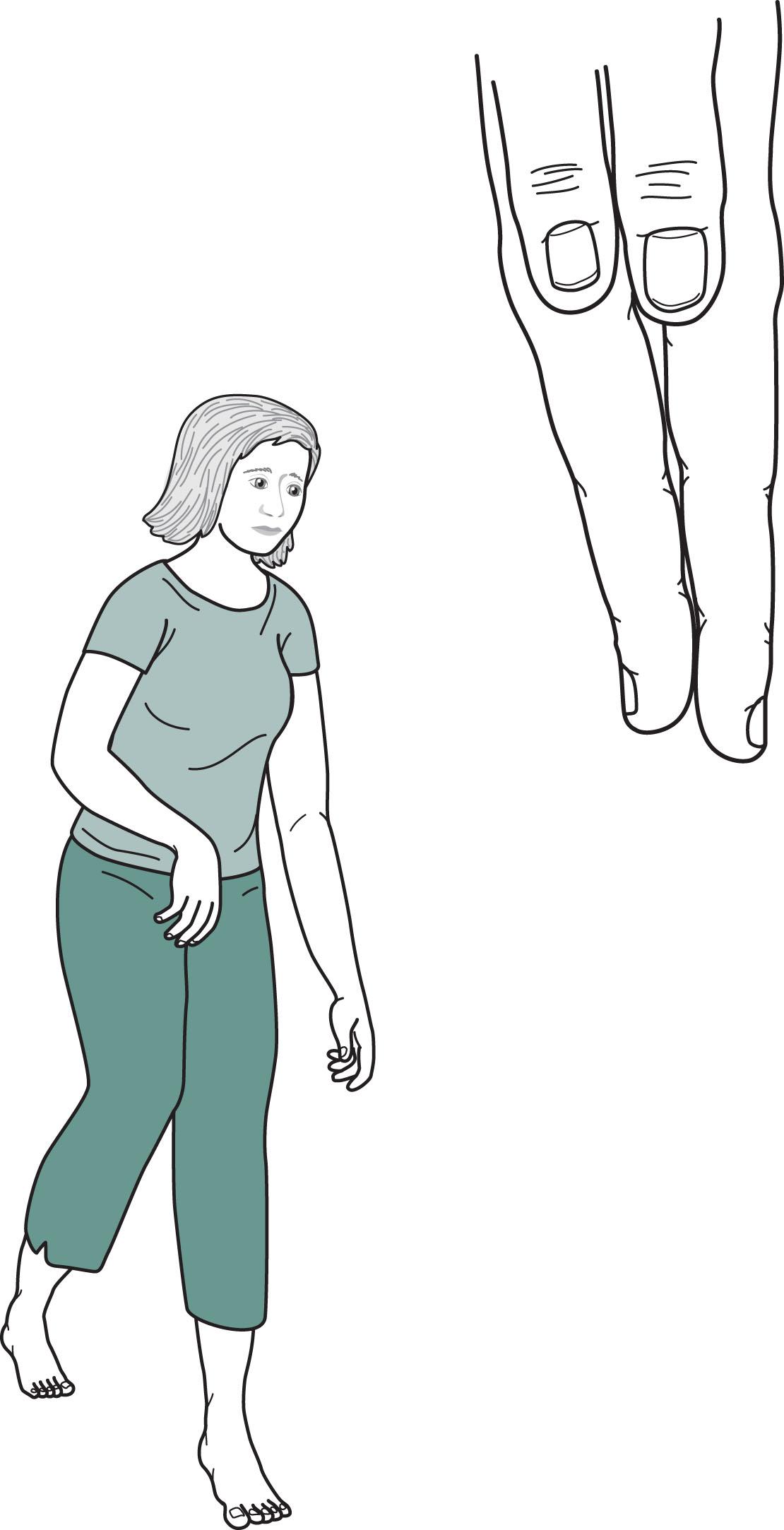
Quadriplegic CP (spastic quadriplegia) consists of paresis of all four limbs, usually accompanied by pseudobulbar palsy. Extensive cerebral damage, often from anoxia during delivery, usually underlies this CP variety. In contrast, cervical spinal cord birth injury causes quadriplegia without cerebral damage.
Physical and occupational therapy, bracing, and orthotics may help children with CP. Neurologists often recommend surgery that transposes or lengthens tendons to extend a joint’s range of motion. To reduce spasticity, which will give the child greater mobility, they prescribe oral medications, such as baclofen, dantrolene, and tizanidine, and administer intramuscular injections of botulinum toxin to select muscle groups (see Chapter 18 ). However, epilepsy in these children resists treatment. Seizure control often requires two or more antiepileptic drugs (AEDs), which may produce undesirable side effects.
Involuntary writhing movements (athetosis) of the face, tongue, hands, and feet punctuated by jerking movements (chorea) of the trunk, arms, and legs—embraced by the term choreoathetosis —define extrapyramidal or dyskinetic CP ( Fig. 13.5 ). Although choreoathetosis may remain subtle throughout a patient’s lifetime, it interferes with fine writing and other fine hand movements, walking, and even sitting. In addition, involuntary larynx, pharynx, and diaphragm movements lead to incomprehensible speech.
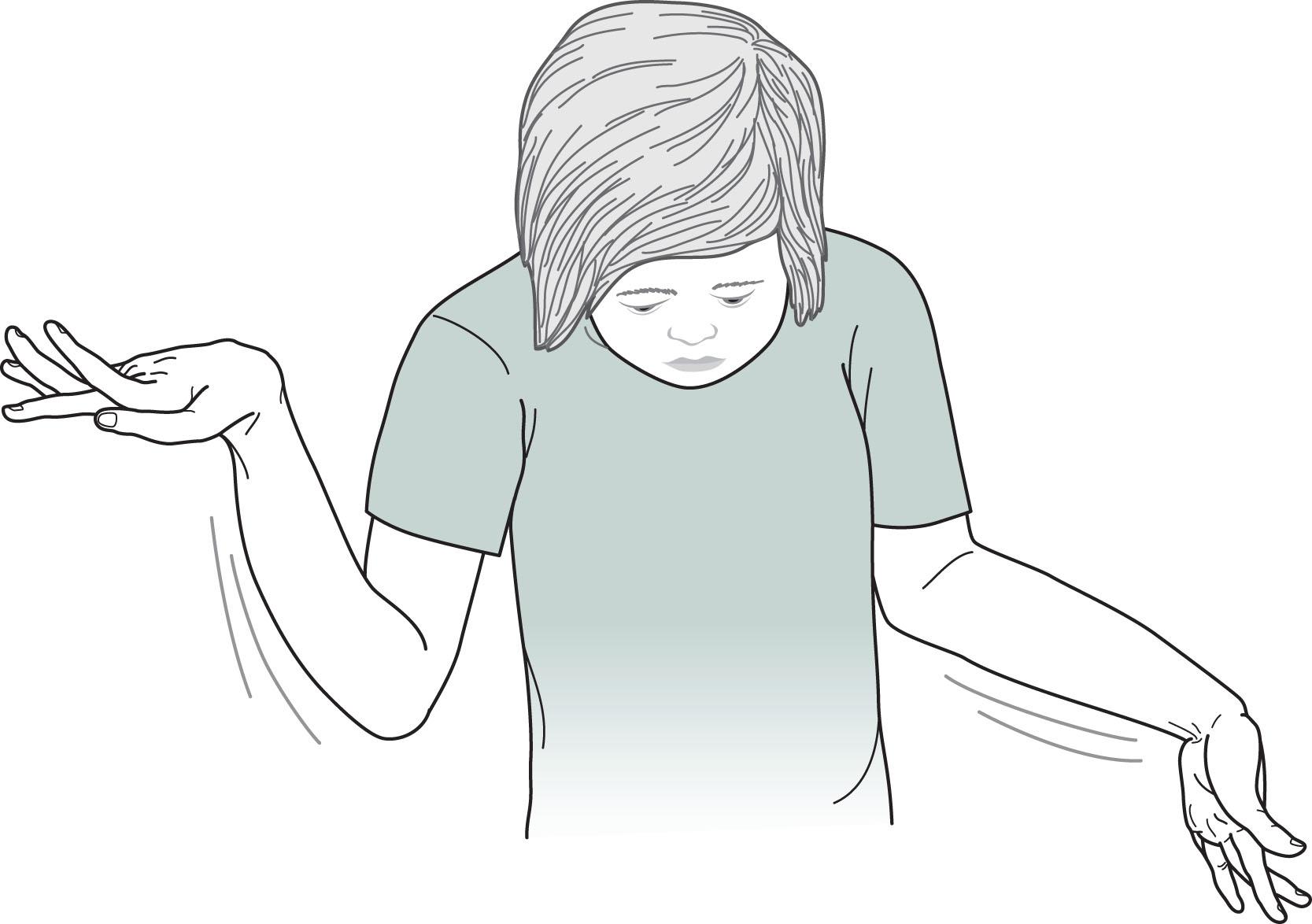
Physicians should distinguish choreoathetotic CP from dopamine-responsive dystonia (DRD) , which produces similar involuntary movements in young children (see Chapter 18 ). In short, unlike CP, DRD is progressive (albeit slowly), fluctuating in a characteristic diurnal pattern at its onset, and, most important, responsive to small doses of levodopa (L-dopa). It mimics extrapyramidal CP so closely that many neurologists insist on a therapeutic trial of L-dopa in dystonic children before accepting a diagnosis of choreoathetotic CP.
Neurologists usually attribute choreoathetotic CP to combinations of low birth weight, anoxia, and neonatal hyperbilirubinemia damaging the basal ganglia (kernicterus) . In addition, because these insults also damage the auditory pathways, hearing impairment frequently complicates the clinical picture.
Unlike spastic CP, choreoathetosis may not become clinically apparent until children are 2 to 4 years old. By that time, when normal children should have acquired steady walking and some fine motor skills, these children’s involuntary movements have usually delayed or prevented them from achieving these and other milestones. Similarly, hearing impairment may remain unnoticed until 1 year of age, when the rudiments of language should commence.
In contrast to the burden of these impairments, probably because kernicterus tends to spare the cerebral cortex, choreoathetotic CP is associated with a relatively low—10%—incidence of epilepsy and Intellectual Disability. A superficial academic or medical evaluation may underrate children with choreoathetotic CP. Despite pronounced physical challenges, many patients with CP complete college. Thus, both choreoathetotic and diplegic CP qualify, along with polio, cervical spinal cord trauma, and DYT1 dystonia, as physically devastating pediatric neurology conditions that allow normal cognition. Children with these conditions benefit from mainstream academic programs.
Medications provide little relief from choreoathetosis. Although deep brain stimulation reduces athetosis, the procedure is not yet optimized in this situation.
Finally, mixed form CP —combinations of spastic paraparesis and choreoathetosis—account for about 15% of cases. This variety reflects the most extensive central nervous system (CNS) injury, naturally associated with the highest incidence of epilepsy and intellectual disability—95%.
During the third and fourth weeks of gestation, the dorsal ectoderm invaginates typically to form a closed, midline neural tube . The tube goes on to seal itself at both ends and form the brain and spinal cord ( Fig. 13.6 , top ). While ectoderm thus gives rise to the CNS, mesoderm gives rise to its coverings—the meninges, vertebrae, and skull.
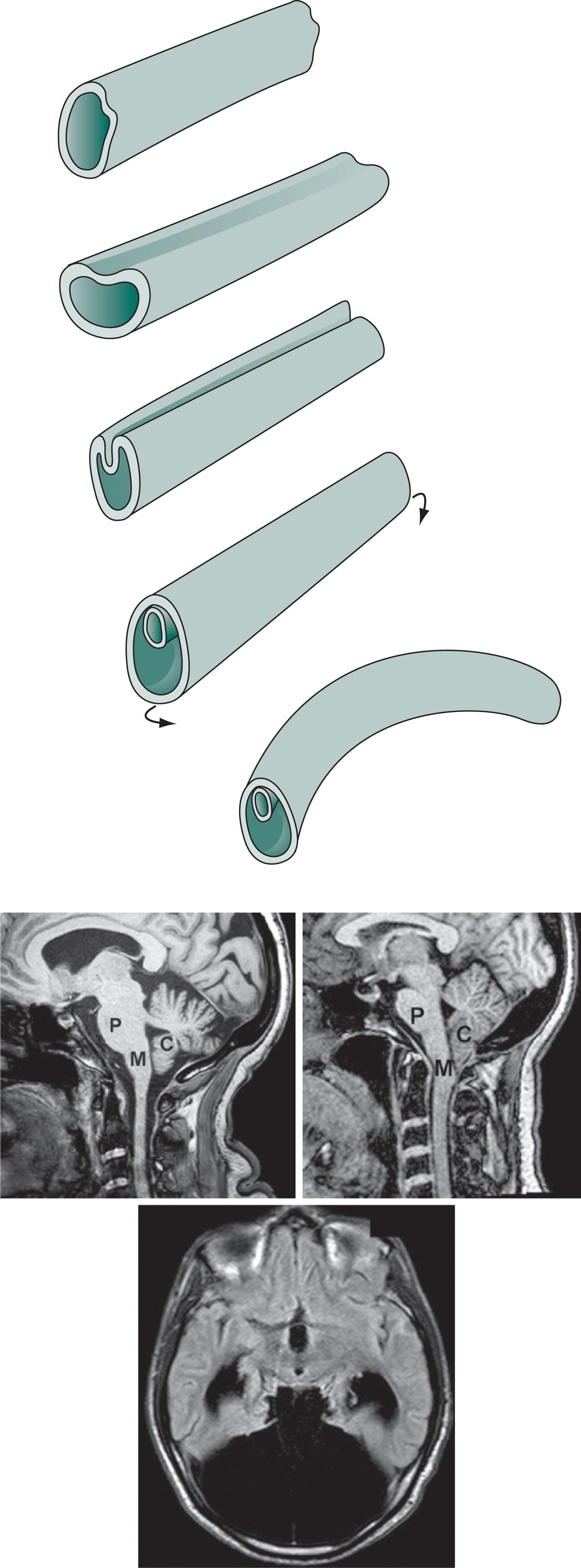
The neural tube sometimes does not follow the choreography and fails to fuse at one or both ends. In other words, the neural tube may not close at the prospective site of the brain or lower end of the spinal cord. These defects expand during embryogenesis and lead to brain malformations, lower spinal cord, or both. In addition, defects in the surrounding meninges and either lumbosacral vertebrae or skull fail to cover neural tube defects. Beyond the neurologic issues, neural tube defects create some of the most heart-wrenching controversies in medicine, such as whether to continue treating severely malformed infants and the burden of tremendous health care costs for infants with a dismal prognosis.
In an extreme example of a neural tube defect, the entire upper end fails to form. In this case, anencephaly , the fetus lacks a brain or has one consumed by a significant, often cavitary, malformation.
A relatively common group of malformations collectively termed the Arnold-Chiari malformation constitute a variety of upper neural tube closure defects. Not evident by external appearances, the Arnold-Chiari malformation consists of downward displacement of the lower portion of the medulla and cerebellum through the foramen magnum (see Figs. 13.6 and 20.22 ). In older children and adults, who may previously have escaped detection, this malformation often produces head and neck pain (especially when bending) and, in severe cases, bulbar palsy. Patients with compression of the medulla or cerebellum often require “unroofing”—surgical removal of the lamina of the upper cervical spine and excision of a portion of the occipital bone of the skull.
In an encephalocele , a malformed brain, covered only by its skin and meninges, but bathed in its cerebrospinal fluid (CSF), protrudes through an occipital skull defect. In a similar malformation, the Dandy-Walker syndrome , the posterior portion of the upper neural tube fails to mature (see Fig. 13.6 ).
Upper neural tube defects are associated with comparable lower neural tube defects. In the most benign variety of lower neural tube defects, spina bifida occulta , lumbar vertebrae simply fail to fuse. With both the underlying spinal cord and cauda equina remaining intact, this disorder usually remains asymptomatic. In meningocele , a more severe variety, the meninges protrude through a lumbosacral spine and skin defect to form a prominent, CSF-filled bulge.
Meningomyelocele (myelomeningocele) consists of a tangle of a rudimentary lower spinal cord, lumbar and sacral nerve roots, and meninges that protrude into a saclike structure overlying the lumbosacral spine ( Fig. 13.7 ). The disrupted nerve tissue causes paraparesis, areflexia, incontinence, and hydronephrosis. In addition, hydrocephalus and other brain abnormalities are comorbid in about 25% of cases.
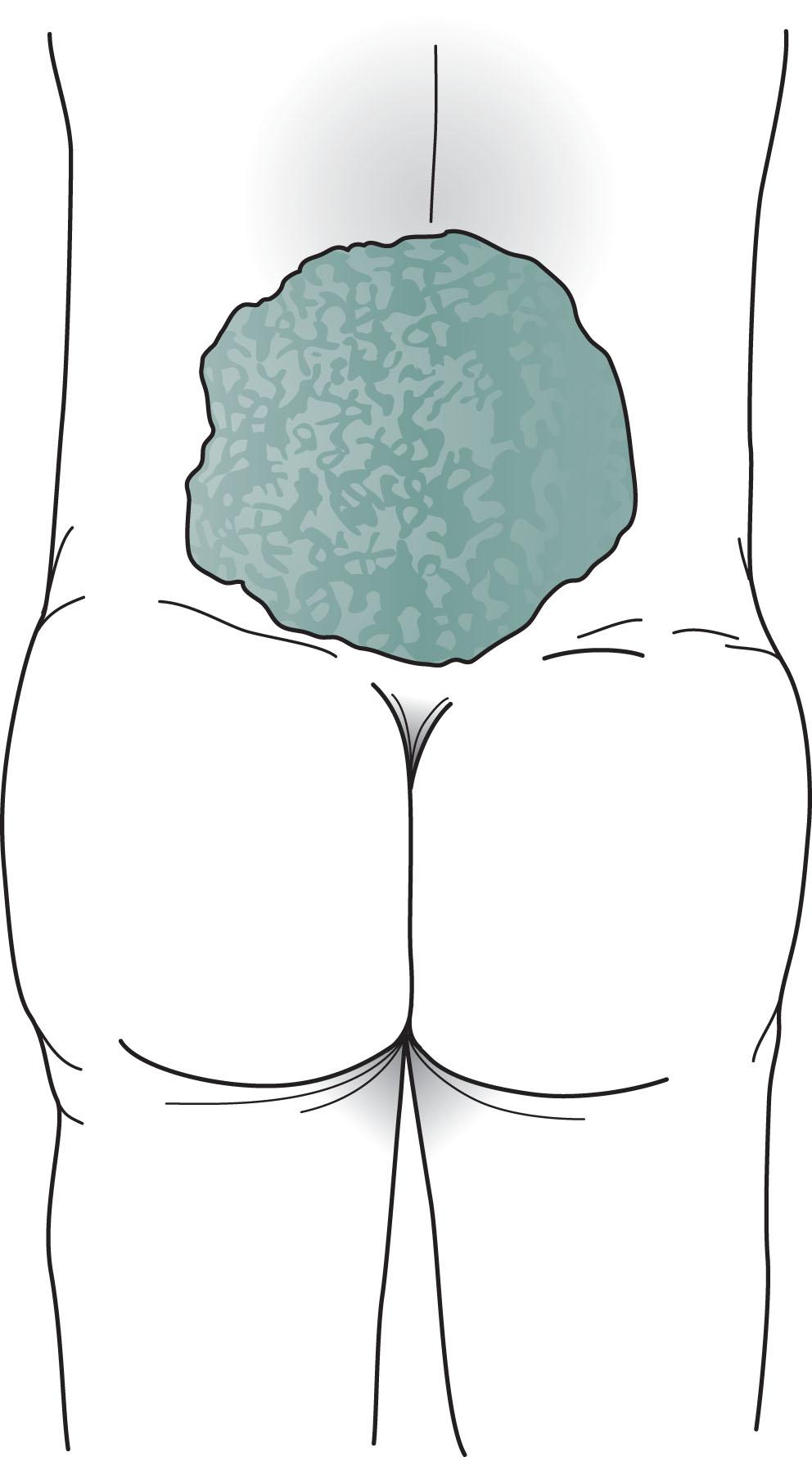
Meningoceles and meningomyeloceles also deprive the lower CNS of the multiple typical coverings (skin, vertebrae, and meninges) that shield it from the environment. To prevent bacteria from entering the CSF through defective meninges and causing meningitis, neonates with meningoceles must undergo neurosurgery within 3 days of birth, not to correct the paraplegia, which is uncorrectable, but to prevent meningitis. Many neonates with a meningomyelocele eventually require permanent ventricular shunting to treat hydrocephalus. In addition, as affected children mature, they often require urinary- and fecal-diversion procedures, revision of ventricular shunts, and further spine surgery. Some recent publications have described in utero or “prenatal” meningomyelocele surgery that reduces the risk of death and the need for shunting. Still, so far, the long-term outcome is unknown.
In the United States, the incidence of neural tube defects is 1 in 2000 births. Studies have implicated several genetic mutations. For example, the risk of a neural tube defect occurring in a sibling of an affected child is 5%. With two affected children, the risk in a third increases to 10%. Similarly, the concordance rate for dizygotic twins is 4%, and for monozygotic twins, almost 8%. Another indicator of a genetic basis of neural tube defects is its frequent occurrence in infants with trisomy 13 or trisomy 18.
Other studies have attributed neural tube defects to environmental factors: the AEDs carbamazepine and valproate, folic acid deficiency, autoantibodies to folate receptors, radiation, and toxins, including potato blight. No complete explanation for the link between AEDs and neural tube defects exists, but AEDS reduces serum folate levels and thus raises homocysteine levels. Whatever the explanation, neurologists avoid prescribing carbamazepine or valproate to women who are pregnant or may conceive. Offsetting the potential teratogenic effects of AEDs by folic acid supplements (see later) has not been shown to be safe or effective.
Prenatal testing may provide an early warning of a neural tube defect. For example, excessive concentrations of α-fetoprotein in amniotic fluid and maternal serum indicate a neural tube defect. Fetal ultrasound examination, a complementary test, may show neural tube defects and other congenital malformations.
Reflecting that folic acid deficiency is a risk factor for neural tube defects, studies found a folic acid intake of 5 mg daily before conception and during the first month of pregnancy reduces the incidence of neural tube defects by 85%. Even eating adequate amounts of fruits and vegetables, which contain folic acids and other nutrients, reduces the risk of neural tube defects by 70%. Based on this data, many countries, including the United States, have mandated folic acid fortification of wheat flour, rice, and cereals.
Embryologic defects in the ectoderm also give rise to neurocutaneous disorders consisting of paired brain and skin abnormalities. In addition, these disorders often include abnormalities of other organs. The neurocutaneous disorders, which neurologists sometimes call the phakomatoses (Gk. phakos , lentil [bean shaped]), allow for the quintessential diagnosis by inspection.
Neurocutaneous disorders usually develop either as spontaneous mutations or are inherited in an autosomal dominant pattern. Although patients’ cutaneous component usually remains stable through adult life, they often have progressive neurologic deterioration. The symptoms and time course of some disorders mimic ASD.
The classic triad of tuberous sclerosis stigmata consists of epilepsy, intellectual disability, and conspicuous smooth and firm nodules, facial angiofibromas (adenoma sebaceum) on the malar surface of the face ( Fig. 13.8 ). Although this illness-defining lesion often first appears only in adolescence, during infancy and childhood, the skin shows several other characteristics: hypopigmented (hypomelanotic) macules and ash-leaf spots; shagreen patches , which are leathery, scaly areas, on the lower trunk and buttocks; and ungual fibromas.
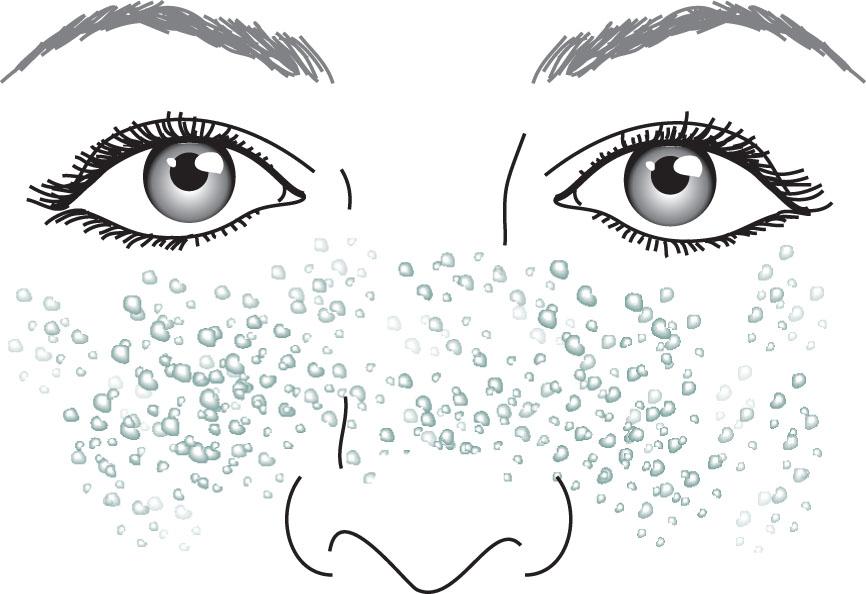
Seizures, which occur in up to 80% of patients, are the most common initial symptom of tuberous sclerosis. Refractory epilepsy portends intellectual disability that worsens as children mature. Intellectual disability often reaches the severity of dementia and forces children with tuberous sclerosis into group homes; however, some children have only minimal cognitive impairment and readily controlled epilepsy. Nevertheless, 30% to 50% of children with tuberous sclerosis show attention-deficit/hyperactivity disorder (ADHD) or ASD symptoms. Thus, neurologists consider tuberous sclerosis one of several neurologic causes of ASD symptoms (see Box 13.1 ).
The disease’s name derives from the characteristic subependymal tubers (Latin tuber , swelling), which are small, potato-like nodules, 1 to 3 cm in diameter, in the brain that tend to line the ventricles. Another characteristic is subependymal giant cell astrocytomas (SEGAs) that frequently grow, compress, irritate, and damage the surrounding cerebral cortex. Growths at the foramen of Monroe block the flow of CSF and cause hydrocephalus.
Although an autosomal dominantly transmitted mutation causes tuberous sclerosis, the mutation has occurred de novo in about 70% of cases. Whether inherited or spontaneous, the mutation involves either of two tumor suppressor genes: the tuberous sclerosis complex 1 (TSC 1) on chromosome 9, which codes for the protein hamartin, or the tuberous sclerosis complex 2 (TSC 2) on chromosome 16, which codes for the protein tuberin. Conventional genetic testing will uncover one or the other of these mutations in 80% to 90% of patients, leaving a few diagnosed by clinical and pathological criteria.
Especially because tubers tend to calcify, computed tomography (CT) and even plain skull X-rays may identify them by their telltale calcifications; however, magnetic resonance imaging (MRI) is the best diagnostic test. Removing the tubers may reduce intracranial pressure, relieve obstructive hydrocephalus, excise a malignancy, and reduce seizure frequency, but neurosurgery is usually not feasible because tubers are numerous and deeply situated. In a breakthrough, studies have shown that inhibitors of the mammalian target of rapamycin (mTOR) , such as everolimus and sirolimus, shrink SEGAs. This medicine also shrinks kidney and liver tumors. Topically applied mTOR inhibitors also reduce facial angiofibromas. However, studies so far have not shown they improve cognition or autism symptoms.
Neurofibromatosis type 1 (NF1) —previously called von Recklinghausen disease or “peripheral type” neurofibromatosis—also causes a clinical triad: multiple café au lait spots, neurofibromas , and Lisch nodules . Café au lait spots, the signature of neurofibromatosis, are areas of uniformly light brown, oval, and flat skin ( Fig. 13.9 ). Although individual café au lait spots are found in at least 10% of normal individuals, more than six, each larger than 5 mm in children and 1.5 cm in adults, is a reliable sign of NF1. Freckling in the axilla and groin—skin surfaces sheltered from sun exposure—is a related sign of the disorder and one of the diagnostic criteria.
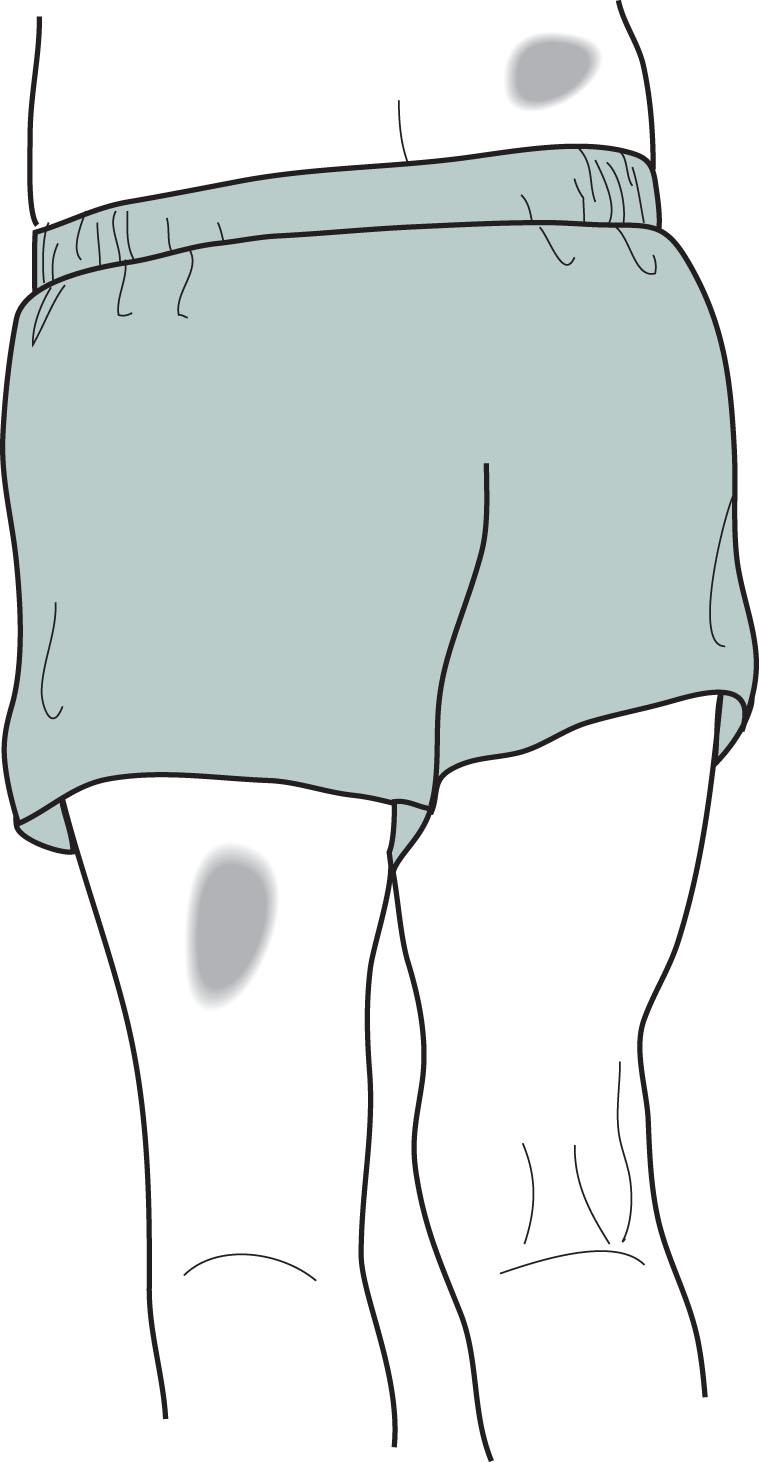
Neurofibromas consist of soft, palpable, subcutaneous growths, each a few millimeters to several centimeters in size, that emerge along peripheral nerves ( Figs. 13.10 and 13.11 ). They can also grow from nerve roots within the spinal canal and compress the spinal cord or cauda equina. They occasionally reach grotesque proportions or induce extraordinary growth of the head or affected limb. However, the famous 19th-century “Elephant Man,” Joseph Merrick, commonly cited as having neurofibromatosis, probably suffered from a different but related condition, Proteus syndrome.
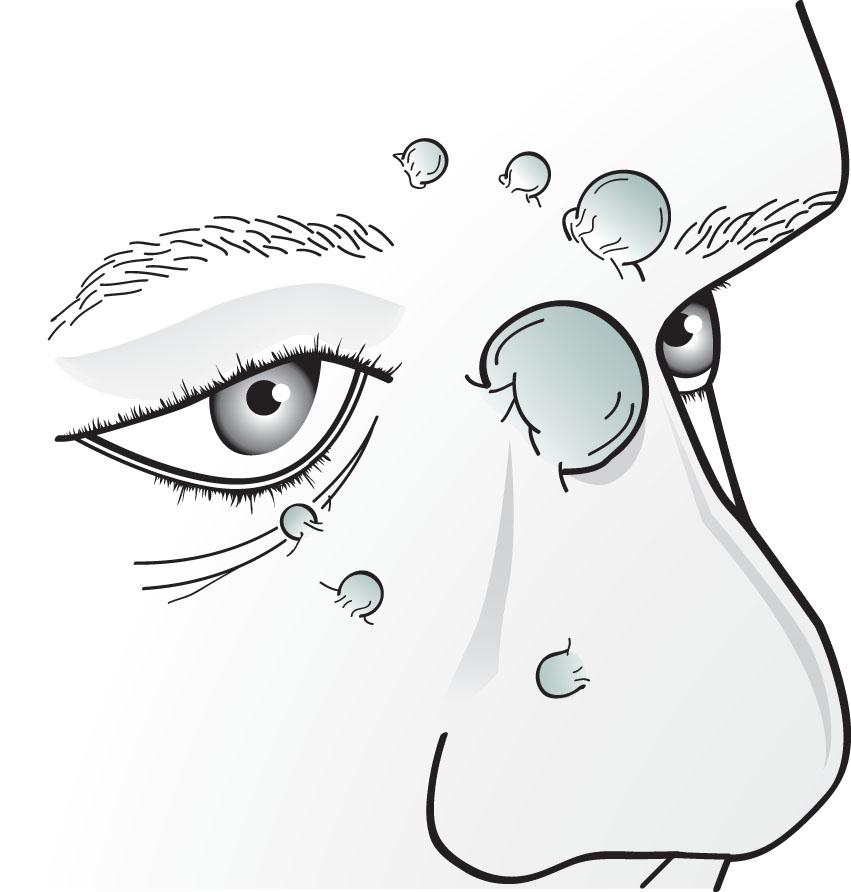
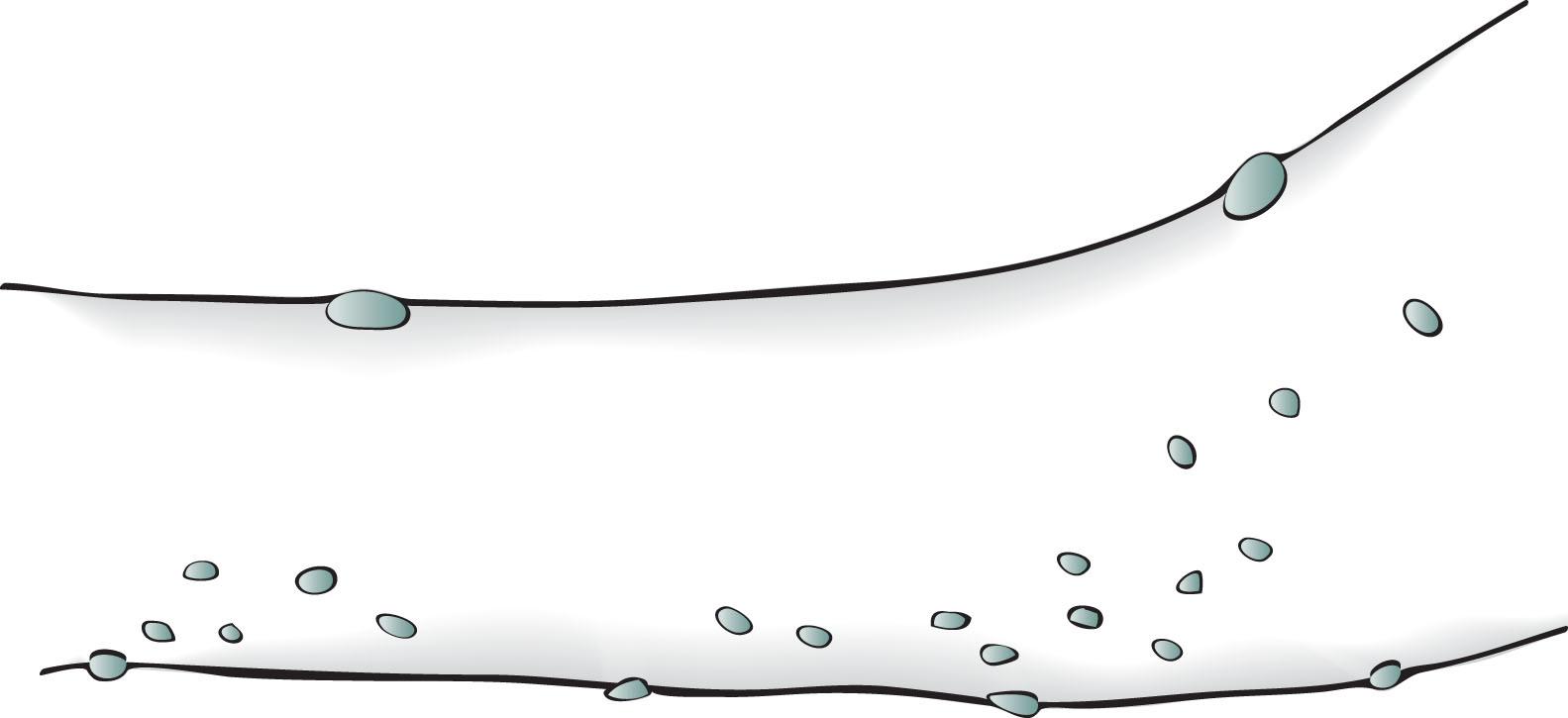
Lisch nodules, the least obvious but most common manifestation, are multiple, asymptomatic, macroscopic, yellow to brown nodules (melanocytic hamartomas) situated on the iris ( Fig. 13.12 ). Although ophthalmologists may need a slit-lamp examination to detect Lisch nodules and differentiate them from inconsequential pigment collections, Lisch nodules are almost pathognomonic of NF1.
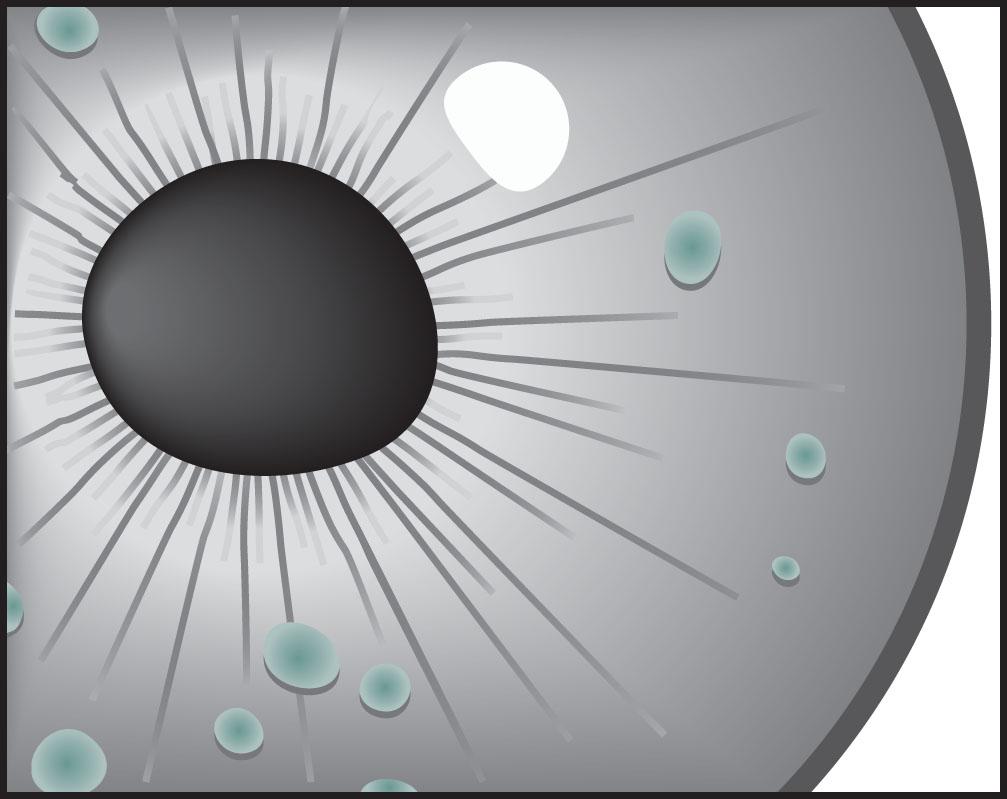
Excision of neurofibromas, except those compressing the spinal cord or other vital structures, is impractical because NF1 involves innumerable peripheral nerves, and the neurofibromas tend to recur. Recent studies have shown that a protein kinase inhibitor, selumetinib, can shrink inoperable plexiform neurofibromas. If necessary, laser therapy can blanch café au lait spots .
Far from being entirely peripheral, NF1 induces intracerebral tumors, particularly optic nerve gliomas, as well as intraspinal neurofibromas. It often causes ADHD, learning disabilities, and a decrease of about 5 to 10 IQ points. Less than 10% of NF1 children show intellectual disability . Although 20% to 40% may display some ASD symptoms, most patients’ problems consist predominantly of social-communication impairments, and psychosis occurs at no greater frequency than in the general population. In contrast to tuberous sclerosis, seizures develop in only 10% to 20 % of patients with NF1.
Approximately 50% of patients inherit NF1 in an autosomal dominant pattern. In the remainder, NF1 arises sporadically. The mutation consists of an abnormality in a tumor-suppressor gene on chromosome 17. (The mnemonic for recalling the abnormal chromosome is “von Recklinghausen” contains 17 letters.”)
Neurofibromatosis type 2 (NF2) , which occurs only 10% as frequently as NF1, is an entirely different disorder. NF2, also called familial acoustic neuroma with good reason, is characterized by bilateral acoustic neuromas (vestibular schwannomas) that steadily impair hearing until deafness ensues (see Fig. 20.27 ). NF2 is usually unrecognized until acoustic neuromas are discovered. Gadolinium-enhanced MRIs can readily show acoustic neuromas. Gamma radiation or laser surgery may burn away the tumor while sparing the acoustic nerve.
Unlike NF1, NF2 does not cause behavioral, learning, or other cognitive impairments. Also, the NF2 mutation is carried on chromosome 22 and, in most cases, transmitted in an autosomal dominant pattern. (The mnemonic for its inheritance is “Chromosome 22 carries the NF2 mutation.”)
Sturge-Weber syndrome, more formally known as encephalo-trigeminal angiomatosis , consists simply of angioma of both the face and underlying cerebral hemisphere. The facial angioma consists of a deep red discoloration (“port-wine stain”) in the distribution of one or more divisions of the trigeminal nerve ( Fig. 13.13 ). Clinicians must distinguish this angioma from more common benign skin abnormalities, such as small forehead angiomas (“strawberry nevi”). The size of the facial angioma in Sturge-Weber does not correlate with the cerebral abnormality as much as its location. Overall, cerebral abnormalities are associated with facial angiomas in only 8% of cases, but cerebral abnormalities are related to facial angiomas in the distribution of the first division of the trigeminal nerve in about 33% of cases. Moreover, first division angiomas lead to glaucoma and headache. If port-wine stains are a component of Sturge Weber syndrome, laser therapy can bleach them.
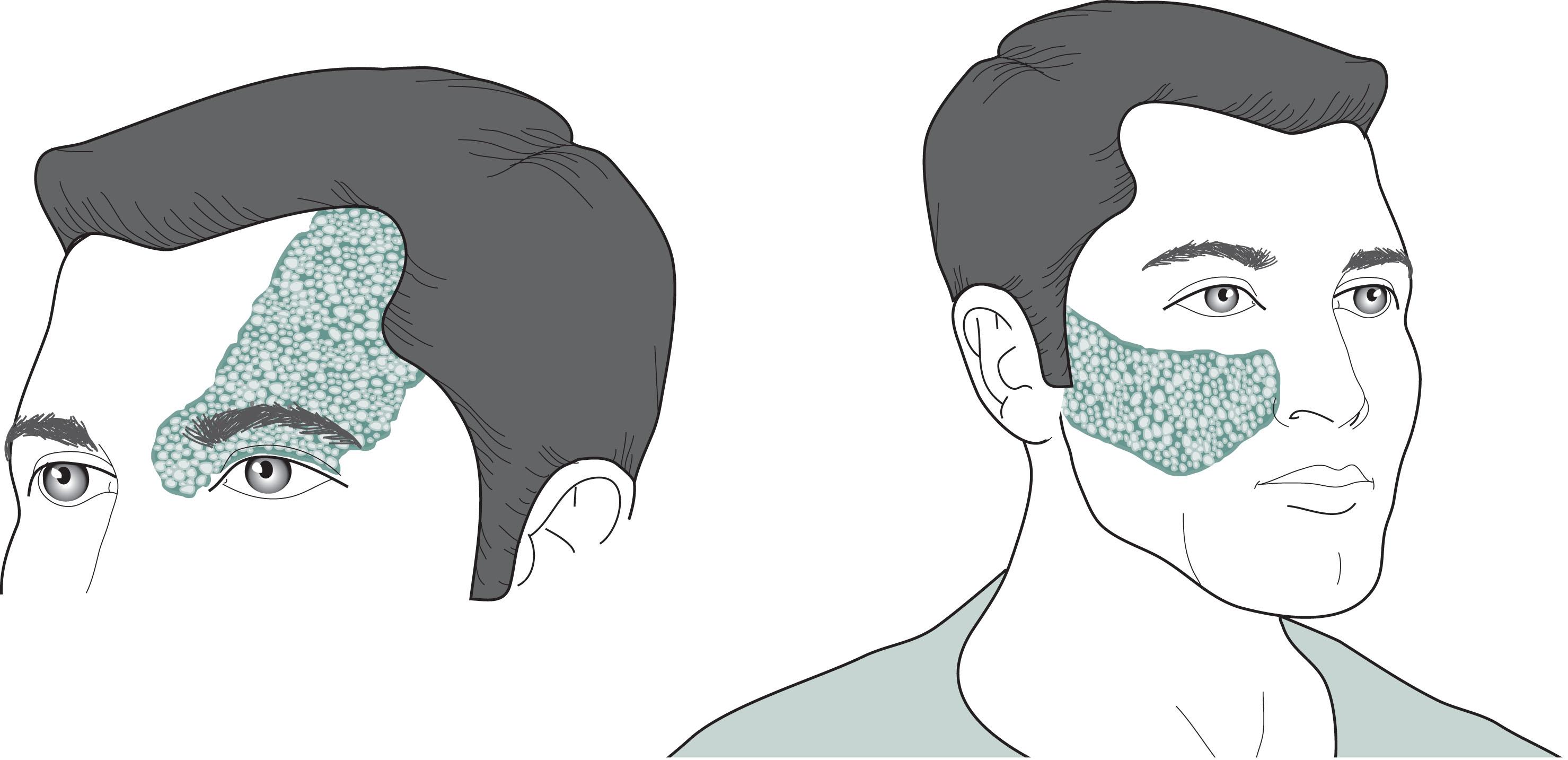
The CNS component of Sturge-Weber syndrome consists of atrophic, calcified layers of the cerebral cortex in the hemisphere underlying the facial vascular malformation. Although CT and even plain X-rays may reveal calcified cerebral parallel lines (“tram-tracks”), neurologists usually require MRI with contrast to show the presence and extent of the lesion.
A somatic mutation causes both Sturge-Weber syndrome and port-wine stains. The mutation is not inherited.
Children with Sturge-Weber almost always have seizures that often begin in infancy and are often refractory to AEDs. Seizures in the first year of life portend intellectual disability. Especially if they have seizures, most children with Sturge-Weber have slowed acquisition of milestones and learning disabilities. Approximately one-third will have pronounced intellectual disability.
Reflecting the underlying cerebral lesion, patients have contralateral neurologic deficits, such as homonymous hemianopsia and spastic hemiparesis. Their physical and cognitive deficits often worsen as children age, possibly due to increasing sclerosis surrounding the cerebral lesions or microhemorrhages within the lesions
At one time, neurologists called this neurocutaneous disorder Madame Louis-Bar disease, making it one of the few conditions named after a woman physician. The neurologic component of ataxia-telangiectasia is progressively severe gait ataxia that appears in children aged 3 to 5 years. Although other motor impairments follow, ataxia usually forces patients to depend on a wheelchair by the time they reach 21 years old.
The cutaneous component consists of aggregations of small, dilated vessels (telangiectasia) conspicuous on the conjunctiva but also present on the cheeks and bridge of the nose. Eventually, cognitive and language functions deteriorate, but not to the extent of the motor deficits. As with Rett syndrome, ataxia-telangiectasia also causes deceleration of head growth that leads, as the child ages, to acquired microcephaly (head circumference less than 2 SD smaller than the mean).
Another hallmark of ataxia-telangiectasia is its consistent association with deficiency of both cellular immunity and immunoglobulins IgA and IgE. The immunodeficiency leads to severe sinus and respiratory tract infections. In adolescence and early adulthood, patients tend to develop lymphomas, leukemia, and other neoplasms. (The same association of lymphoma with immunodeficiency occurs in human immunodeficiency virus [HIV] infection and antirejection drug treatment for organ transplantation.)
Unlike most other neurocutaneous disorders, ataxia-telangiectasia is inherited in an autosomal recessive pattern. It results from a mutation on chromosome 11 that interferes with DNA repair.
Become a Clinical Tree membership for Full access and enjoy Unlimited articles
If you are a member. Log in here